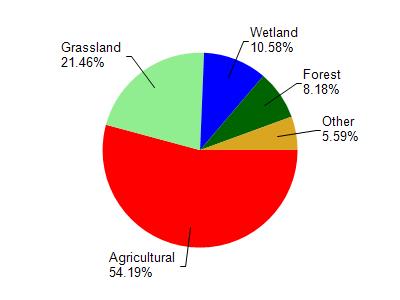Brown
No
No
No
Fish and Aquatic Life
Overview
Lilly lake is a seepage lake, having moderately clear water and a well buffered shoreline. There are no residents on the lake but there is a Brown County Park on the north end with two fishing platform. Due to the limited number of lakes in Brown County, there is substantial recreational usage. The lake has a no gasoline motor restriction or history of winterkill. An aerator is now used to maintain dissolved oxygen levels during the winter. Water chemistry sampling conducted during 2008 and 2007 indicated Lilly lake to be mesotrophic, with concerns about declining water quality and increasing summer algal blooms. Using a series of lake planning grants (sponsored by the Town of Eaton), the Brown County Planning Commission collected data and developed a Comprehensive lake Management Plan which was submitted in December 2009. DNR research conducted a point intercept aquatic plant survey on Lilly Lake on August 21, 2008. Neither Eurasian watermilfoil (EWM) or curly-leaf pondweed (CLP) were found at the time of the survey.
Date 2011
Author Aquatic Biologist
Historical Description
In the fall of 2008, a DNR fish management team conducted a two-night electroshock survey and population estimate for Lilly Lake. They found a large number of largemouth bass, but only one fish greater than 14 inches, which suggests a heavy harvest of legal fish 14 inches or larger (Rowe, 2008).
Historical records indicate that largemouth bass and panfish generally dominate the fisheries in these lakes. Additionally there are a number of spring ponds and wetlands that are identified as “quality wetlands” through the state’s coastal wetland inventory and the USFWS Special Wetlands Inventory Study.
Date
Author Mary Gansberg
Condition
Wisconsin has over 84,000 miles of streams, 15,000 lakes and milllions of acres of wetlands. Assessing the condition of this vast amount of water is challenging. The state's water monitoring program uses a media-based, cross-program approach to analyze water condition. An updated monitoring strategy (2015-2020) is now available. Compliance with Clean Water Act fishable, swimmable standards are located in the Executive Summary of Water Condition in 2018. See also the 'monitoring and projects' tab.
Reports
Recommendations
Engage Volunteers in Monitoring/Restoration
Basin staff should establish a self-help lake monitoring program on Lilly Lake.
Management Goals
Wisconsin's Water Quality Standards provide qualitative and quantitative goals for waters that are protective of Fishable, Swimmable conditions [Learn more]. Waters that do not meet water quality standards are considered impaired and restoration actions are planned and carried out until the water is once again fishable and swimmable
Management goals can include creation or implementation of a Total Maximum Daily Load analysis, a Nine Key Element Plan, or other restoration work, education and outreach and more. If specific recommendations exist for this water, they will be displayed below online.
Monitoring
Monitoring the condition of a river, stream, or lake includes gathering physical, chemical, biological, and habitat data. Comprehensive studies often gather all these parameters in great detail, while lighter assessment events will involve sampling physical, chemical and biological data such as macroinvertebrates. Aquatic macroinvertebrates and fish communities integrate watershed or catchment condition, providing great insight into overall ecosystem health. Chemical and habitat parameters tell researchers more about human induced problems including contaminated runoff, point source dischargers, or habitat issues that foster or limit the potential of aquatic communities to thrive in a given area. Wisconsin's Water Monitoring Strategy was recenty updated.
Grants and Management Projects
Monitoring Projects
| WBIC | Official Waterbody Name | Station ID | Station Name | Earliest Fieldwork Date | Latest Fieldwork Date | View Station | View Data |
|---|
| 82900 | Lilly Lake | 10029000 | Lily Lake -- Access at Lily Lake County Park | 6/29/1994 | 8/6/2025 | Map | Data |
| 82900 | Lilly Lake | 053668 | Lily Lake - Fishing Pier/Boat Dock | 9/26/2017 | 9/26/2017 | Map | Data |
| 82900 | Lilly Lake | 10047646 | Lily Lake | 7/27/1999 | 6/6/2020 | Map | Data |
| 82900 | Lilly Lake | 053650 | Lily Lake - Shoreline Near Legion | 5/13/1998 | 5/13/1998 | Map | Data |
| 82900 | Lilly Lake | 053228 | Lily Lake - Deepest Part | 5/11/1995 | 8/30/2025 | Map | Data |
| 82900 | Lilly Lake | 363044 | Lilly Lake - Deep Hole | 2/17/1994 | 8/25/1994 | Map | Data |
|

Watershed Characteristics
Lilly Lake is located in the West Twin River watershed which is 180.11 mi². Land use in the watershed is primarily agricultural (54.30%), grassland (21.50%) and a mix of wetland (10.60%) and other uses (13.80%). This watershed has 360.91 stream miles, 1,898.59 lake acres and 10,189.53 wetland acres.
Nonpoint Source Characteristics
This watershed is ranked High for runoff impacts on streams, Medium for runoff impacts on lakes and High for runoff impacts on groundwater and therefore has an overall rank of High. This value can be used in ranking the watershed or individual waterbodies for grant funding under state and county programs.However, all waters are affected by diffuse pollutant sources regardless of initial water quality. Applications for specific runoff projects under state or county grant programs may be pursued. For more information, go to surface water program grants.